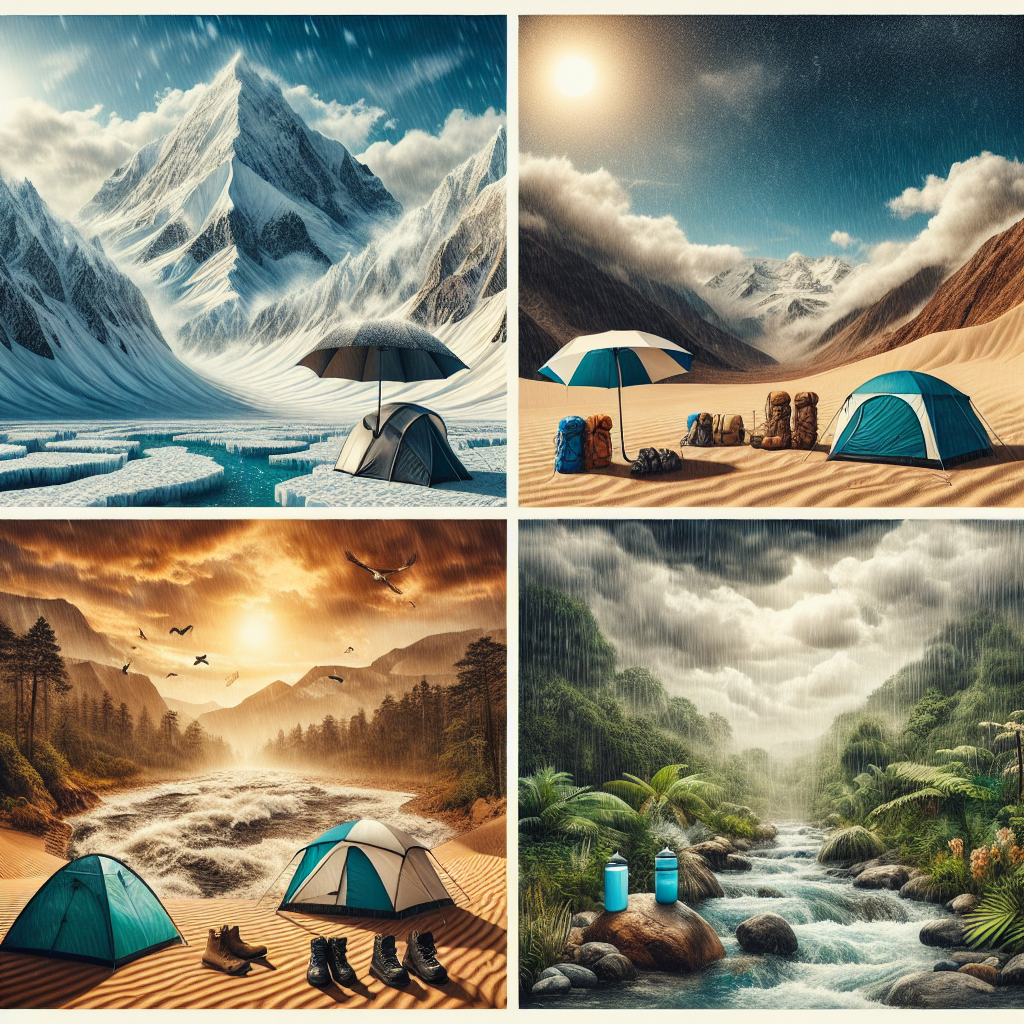Embarking on an exciting camping trip? Whether it’s the icy grips of winter, the balmy days of summer, the blossoming aura of spring, or the crisp evenings of autumn, your adventure can span a myriad of climatic conditions. The article “Camping in Different Climates: Adaptation and Preparation” is a handy guide to not just surviving, but thriving in your camping adventure, regardless of the weather. It provides crucial insights and practical tips on how to adapt and prepare effectively for every varied climate ensuring a secure, comfortable, and memorable camping experience.

Understanding Climate Zones for Camping
Before heading out to camp in the wild, it’s essential to comprehend the importance of climate zones. The uniqueness of each climate zone can drastically modify your camping experience. The climate zone signifies the type of weather you’ll likely encounter based on geographic location. It influences the terrain, flora, fauna, and, most importantly, what you need to pack and how you should prepare.
Fundamentals of climate zones
Climate zones refer to specific regions around the globe demonstrating similar patterns of weather, temperature, precipitation, and seasonal changes. These patterns majorly influence landforms, ecosystem, and human lifestyle. When considering camping, the climate zone determines the gear needed, the type of terrain, fauna, and flora you can expect.
Identification of the five major climate zones
The five major climate zones of the world are polar, temperate, tropical, arid, and highland. Polar climates are characterized by harsh cold temperatures, while temperate zones experience a mild and moderate environment. Tropical climates are typically hot and wet, arid areas are hot and dry, and highland climates fluctuate with altitude.
Relation between climate zones and camping
Understanding climate zones is crucial for camping. The varying weather patterns, temperatures, and landscapes across climate zones impact your choice of camping gear, food, clothing, and overall camping preparation. Additionally, it helps you anticipate potential risks and obstacles making your camping experience safer and more enjoyable.
Camping in Temperate Climates
Temperate climates provide a wonderful balance of conditions suitable for camping. Its versatility ranges from peaceful beachfronts, lush forests, to awe-inspiring mountain ranges.
Characteristics of temperate climates
Temperate climates are characterized by moderate temperatures, not too hot or cold, with distinct seasonal changes. The precipitation spreads throughout the year, but most rainfall occurs during the winter.
Preparing for camping in temperate climates
For camping in temperate climates, packing versatile clothing is recommended due to the climate’s variableness. Ensure you pack insulation layers including a fleece or down jacket, along with waterproof gear for potential rain.
Adapting to temperate climate conditions
In temperate climates, accustoming yourself to fluctuating temperatures is crucial. Always check weather updates and plan your activities accordingly. Building a campfire during cold nights and setting up a shaded area during warmer days will create a comfortable camping environment.
Camping in Tropical Climates
Camping in the world’s tropical regions can promise lush landscapes, exotic wildlife, and a truly unique experience.
Characteristics of tropical climates
Tropical climates are usually hot with high humidity. Rain is frequent and heavy, particularly during the rainy season. The climate remains warm throughout the year, with little temperature drop at night.
Preparing for camping in tropical climates
When camping in a tropical climate, your gear should be waterproof, and clothing should be lightweight, breathable, and quick-drying. Pack plenty of water to stay hydrated and don’t forget your insect repellent!
Adapting to tropical climate conditions
In tropical conditions, staying cool and avoiding dehydration are essential. Choosing a campsite with plenty of shade and near a water source is advisable. Also, be vigilant about insects and other creatures that may pose potential hazards.
Camping in Polar Climates
If you’re up for braving the extreme cold, camping in a polar climate can be a tough yet rewarding adventure.
Characteristics of polar climates
Polar climates are among the most extreme on earth, exhibiting harsh cold temperatures all year round with little to no precipitation most of the year.
Preparing for camping in polar climates
Planning a trip to polar climates demands gear designed specifically for extreme cold conditions. Thermal clothing, a four-season tent, a cold-weather sleeping bag, and sturdy footwear are among the essentials for such a challenging environment.
Adapting to polar climate conditions
In polar climates, it’s crucial to keep warm and stay dry. Regular intake of high-calorie foods and warm beverages can help maintain vital body heat. Also, learning basic survival techniques in snow might come in handy.

Camping in Arid Climates
Arid climates, including deserts, may seem inhospitable, but they offer an unmatched sense of tranquility and unique beauty.
Characteristics of arid climates
Arid regions are characterized by extremely low rainfall, intense sun, high daytime temperatures, and surprisingly cold nights.
Preparing for camping in arid climates
For camping in arid climates, pack lightweight, breathable clothing for the day and warm layers for chilly nights. Carry plenty of water, and remember to bring sunglasses, a hat, and sunscreen.
Adapting to arid climate conditions
In arid conditions, staying hydrated is critically key. It’s also important to stay protected from the sun and seek shade during peak sun hours.
Camping in Highland/ Mountain Climates
Highland or mountain climates offer a variety of ecosystems, beautiful topography, and a direct connection to nature.
Characteristics of highland climates
Highland climates are greatly influenced by altitude. Weather conditions can change rapidly with increasing elevation. Temperatures generally decrease, and precipitation increases with altitude.
Preparing for camping in highland climates
To camp in highland climates, be prepared for changeable weather. Packing clothing layers, rain gear, strong hiking boots, and securing a good quality tent to withstand winds are advisable.
Adapting to highland climate conditions
Adapting to highland climates revolves around managing altitude changes. Giving the body time to acclimatize to the altitude is vital for preventing altitude sickness.
Essential Camping Gear for Different Climates
your camping gear influences your experience significantly and largely depends on the specific climate you’ll be camping in.
Choosing the right tent for all climates
The right tent ensures safety and comfort in different climates. For example, in fierce polar climates, a four-season tent is desirable; for rainy tropical climates, a waterproof tent with good ventilation is essential.
Importance of climate-specific sleeping gear
Investing in an appropriate sleeping bag for the specific climate can mean the difference between a restful night’s sleep and a long restless night. For cold weather, consider a sleeping bag with a low-temperature rating, while in warmer climates, a lighter sleeping bag will suffice.
Climate-appropriate clothing for camping
Climate-appropriate clothing aids adaptation to varying weather conditions. Thermal clothing helps to retain body heat in cold climates, while breathable, moisture-wicking fabrics keep you dry and cool in hotter climates.
Heat and cooking equipment based on climate
Your cooking stove can also be climate-dependent. For example, liquid fuel stoves perform better in freezing temperatures, while canister stoves are lightweight and suitable for milder climates.
Climate-Specific Camping Safety Precautions
Every climate zone has unique hazards it’s important to know how to avoid these and manage any situation that might arise.
Avoiding climate-based hazards
Staying safe often means understanding and avoiding hazards peculiar to different climates, such as heatstroke in arid climates, hypothermia in cold climates, or insect-borne disease in tropical climates.
First aid and health considerations
A well-stocked first aid kit and knowledge of basic first aid are crucial for all camping trips. It should include bandages, antiseptic wipes, tweezers, medical tape, painkillers, and specific medication or equipment for personal medical needs.
Staying safe in extreme temperatures
In extreme temperatures, staying hydrated, limiting physical exertion, wearing appropriate clothing, and finding shelter can help prevent overheating or hypothermia.
How Weather Affects Camping Activities
Climatic conditions significantly influence your camping activities, from hiking and fishing to star gazing and bird watching.
Influence of weather on camping agenda
The climate can determine your daily camping schedule. For instance, arid climates might encourage nocturnal activities when temperatures are cooler, while milder climates might allow for daytime exploration.
Best outdoor activities for different climates
Every climate zone abounds with unique activities suited for its weather. Whether it’s ice-fishing in polar regions, surfing in tropical climates, or hiking in temperate regions, there’s always an adventure to be had.
Adjusting activities based on climate changes
Being flexible with your camping agenda based on weather patterns will ensure safety and enjoyment. Always have a contingency plan in case of adverse changes in weather.
Preserving the Environment while Camping in Different Climates
As we explore and enjoy nature, it’s our responsibility to minimize our impact on the environment, no matter what climate we’re in.
Importance of leaving no trace
The notion of ‘leaving no trace’ is a principle that every camper should abide by. It means leaving the campsite just as you found it, or even cleaner.
Climate-specific considerations for minimizing environmental impact
Considerations to minimize environmental impact varies with the climate. For example, in dry climates, preventing wildfires by proper campfire management is a priority. In snowy climates, avoiding walking over fragile vegetation covered by snow is advisable.
Ensuring conservation of local plant and animal life
Respect for local biodiversity is crucial while camping. Don’t disturb wildlife or damage plants, and always remember to bring back anything you bring in, from food wrappers to broken gear.
Camping in different climates can provide endless adventures. As you face the challenges of diverse climates, preparation and adaptability will serve as your best guides. So, gear up, understand your climate zone, and you’re ready to dive into the incredible world of camping!

